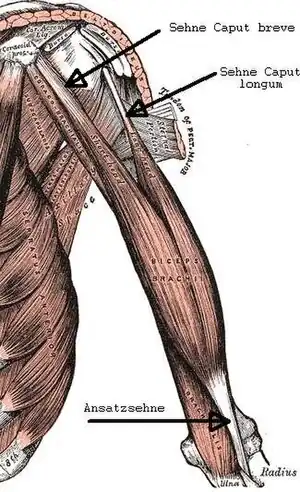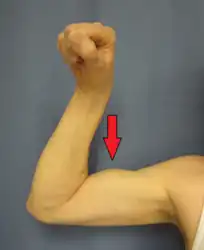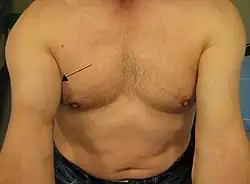Biceps tendon rupture
| Biceps tendon rupture | |
|---|---|
| Other names: Bicep tendon tear | |
 | |
| Anatomy of the biceps muscle with its three tendons labelled | |
| Symptoms | Weakness, pain[1] |
| Usual onset | Proximal: Sudden[1] |
| Types | Proximal, distal[2][3] |
| Causes | Proximal: Overuse[1] Distal: Acute injury[1] |
| Risk factors | Smoking, obesity, corticosteroids, fluoroquinolones, kidney disease[1] |
| Diagnostic method | Based on symptoms and ultrasound[1] |
| Treatment | Proximal: Usually conservative[1] Distal: Usually surgery[2] |
| Frequency | Proximal: More common Distal: 1 in 25,000 per year[2] |
Biceps tendon rupture is a partial or complete break of a tendon of the biceps muscle.[2][3] It can involve the tendons at the shoulder (proximal) or elbow (distal).[2][3] Symptoms of proximal injury may include some weakness and pain when turning your arm palm up.[3] Symptoms of distal injury generally include greater weakness, especially turning the palm up.[2] A "pop" may be felt when it occurs and bruising may develop.[1]
Proximal ruptures usually due to overuse and are related to rotator cuff disease.[1][3] Distal ruptures usually occur as a result of a sudden excessive force such as lifting a heavy object.[1] Risk factors include smoking, obesity, corticosteroid use, fluoroquinolones, and kidney disease.[1] Diagnosis is often based on the symptoms and confirmed by ultrasound.[1]
Proximal ruptures are usually treated without surgery.[1] In athletes or when the appearance is of greater importance surgery may be carried out.[1] Distal ruptures are usually repaired by surgery; except in cases were full strength is not important.[2] Without surgery a 50% reduction in strength may occur.[1]
Rupture of the distal tendon occurs in about 1 in 25,000 people a year.[2] Middle aged males are most commonly affected.[1] Proximal injuries are more commonly and primarily occurs in older people.[1] Proximal tendon rupture was first described in 1781 while distal tendon ruptures were first described in 1843.[4][5]
Signs and symptoms
When a biceps tendon ruptures, the muscle belly changes position in the arm.[6] The bulge that forms is often known as Popeye's deformity, due to the similarity in appearance to the cartoon character Popeye.[6]
 Rupture of the long head of the proximal biceps. Note muscle appears larger.
Rupture of the long head of the proximal biceps. Note muscle appears larger. Rupture of the proximal biceps tendon. Note that the muscle have moved up.
Rupture of the proximal biceps tendon. Note that the muscle have moved up. Proximal biceps tendon rupture on persons right
Proximal biceps tendon rupture on persons right
Causes
A biceps tendon rupture may occur during athletic activities, however avulsion injuries of the distal biceps tendon are frequently occupational in nature and sustained during forceful, eccentric contraction of the biceps muscle while lifting.[7]
Diagnosis

Diagnosis is often based on the symptoms and confirmed by ultrasound.[1] MRI may rarely be used.[1]
Treatment
Distal
Acute rupture of the distal biceps tendon can be treated nonoperatively with acceptable results,[8] but because the injury can lead to 30% loss of elbow flexion strength and 30-50% loss of forearm supination strength, surgical repair is generally recommended.[9][10][11] Complete distal biceps tears are commonly treated with re-attachment of the biceps tendon to its native insertion on the tuberosity of the radius using bone tunnels, suture buttons, or suture anchors.[12][9][13]
Proximal
Proximal ruptures of the long head of the biceps tendon can be surgically addressed by two different techniques. Biceps tenodesis includes release of the long head of the biceps tendon off of its insertion on the glenoid and re-attachment by screw or suture anchor fixation to the humerus. Biceps tenotomy consists of simple release of the long head of the biceps without reattachment to the humerus, allowing the tendon to retract into the soft tissues of the proximal upper arm.[7] Degeneration of the tendon can cause partial tears and are rarely associated with a traumatic event.
Treatment of a biceps tear depends on the severity of the injury. In most cases, the muscle will heal over time with no corrective surgery. Applying cold pressure and using anti-inflammatory medications will ease pain and reduce swelling. More severe injuries require surgery and post-op physical therapy to regain strength and functionality in the muscle. Corrective surgeries of this nature are typically reserved for elite athletes who rely on a complete recovery.[14]Older patients will be treated by long head bicep tenotomy almost without exception.
References
- 1 2 3 4 5 6 7 8 9 10 11 12 13 14 15 16 17 18 19 Hsu, David; Anand, Prashanth; Mabrouk, Ahmed; Chang, Ke-Vin (2022). "Biceps Tendon Rupture". StatPearls. StatPearls Publishing. Archived from the original on 24 January 2022. Retrieved 24 January 2022.
- 1 2 3 4 5 6 7 8 "Biceps Tendon Tear at the Elbow - OrthoInfo - AAOS". www.orthoinfo.org. Archived from the original on 18 May 2021. Retrieved 23 January 2022.
- 1 2 3 4 5 "Biceps Tendon Tear at the Shoulder - OrthoInfo - AAOS". www.orthoinfo.org. Archived from the original on 18 August 2021. Retrieved 23 January 2022.
- ↑ Kerkhoffs, Gino M. M. J.; Servien, Elvire (18 February 2014). Acute Muscle Injuries. Springer Science & Business Media. p. 108. ISBN 978-3-319-03722-6. Archived from the original on 24 January 2022. Retrieved 24 January 2022.
- ↑ Scuderi, Giles R.; Tria, Alfred J.; Berger, Richard A. (27 May 2010). MIS Techniques in Orthopedics. Springer Science & Business Media. p. 90. ISBN 978-0-387-29300-4. Archived from the original on 24 January 2022. Retrieved 24 January 2022.
- 1 2 Yoshida, Naoki; Tsuchida, Yoshihiko (2017-11-16). ""Popeye" Sign". New England Journal of Medicine. 377 (20): 1976–1976. doi:10.1056/NEJMicm1704705. ISSN 0028-4793. PMID 29141167. Archived from the original on 2021-09-23. Retrieved 2021-09-23.
- 1 2 Miller MD, Thompson SR, DeLee J, Drez D (2015). DeLee & Drez's orthopaedic sports medicine : principles and practice (Fourth ed.). Philadelphia, PA. ISBN 978-1-4557-4376-6. OCLC 880421005.
- ↑ Freeman CR, McCormick KR, Mahoney D, Baratz M, Lubahn JD (October 2009). "Nonoperative treatment of distal biceps tendon ruptures compared with a historical control group". The Journal of Bone and Joint Surgery. American Volume. 91 (10): 2329–34. doi:10.2106/jbjs.h.01150. PMID 19797566. Archived from the original on 2021-09-23. Retrieved 2021-09-23.
- 1 2 Morrey BF, Askew LJ, An KN, Dobyns JH (March 1985). "Rupture of the distal tendon of the biceps brachii. A biomechanical study". The Journal of Bone and Joint Surgery. American Volume. 67 (3): 418–21. doi:10.2106/00004623-198567030-00011. PMID 3972866.
- ↑ Baker BE, Bierwagen D (March 1985). "Rupture of the distal tendon of the biceps brachii. Operative versus non-operative treatment". The Journal of Bone and Joint Surgery. American Volume. 67 (3): 414–7. doi:10.2106/00004623-198567030-00010. PMID 3972865.
- ↑ Nesterenko S, Domire ZJ, Morrey BF, Sanchez-Sotelo J (March 2010). "Elbow strength and endurance in patients with a ruptured distal biceps tendon". Journal of Shoulder and Elbow Surgery. 19 (2): 184–9. doi:10.1016/j.jse.2009.06.001. PMID 19664936.
- ↑ Sotereanos DG, Pierce TD, Varitimidis SE (May 2000). "A simplified method for repair of distal biceps tendon ruptures". Journal of Shoulder and Elbow Surgery. 9 (3): 227–33. doi:10.1067/mse.2000.105136. PMID 10888168.
- ↑ Bain GI, Prem H, Heptinstall RJ, Verhellen R, Paix D (March 2000). "Repair of distal biceps tendon rupture: a new technique using the Endobutton". Journal of Shoulder and Elbow Surgery. 9 (2): 120–6. doi:10.1067/2000.102581. PMID 10810691.
- ↑ "Bicep tear - Muscular Injuries". Sports Medicine Information. Archived from the original on 2021-05-06. Retrieved 2021-09-23.